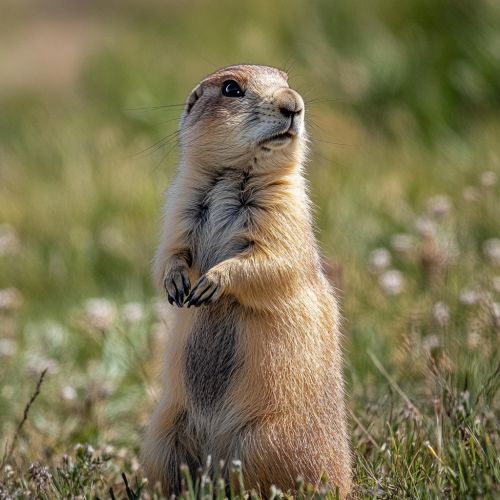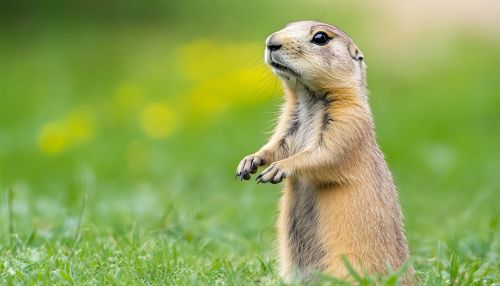Black-tailed Prairie Dog
Introduction
The black-tailed prairie dog (Cynomys ludovicianus) is a rodent species belonging to the family Sciuridae. Native to the grasslands of North America, this species is one of five prairie dog species and is known for its complex social structures and extensive burrowing systems. The black-tailed prairie dog plays a crucial role in its ecosystem, influencing the biodiversity and functioning of the prairie habitats.
Taxonomy and Evolution
The black-tailed prairie dog is classified within the order Rodentia and the family Sciuridae. The genus Cynomys includes five species: the black-tailed prairie dog, the white-tailed prairie dog, the Gunnison's prairie dog, the Utah prairie dog, and the Mexican prairie dog. The species name ludovicianus is derived from the Latin term for the Louisiana Territory, where the species was first described.
Physical Description
Black-tailed prairie dogs are medium-sized rodents, with adults typically measuring 14-17 inches in length and weighing between 1.5 to 3 pounds. They are characterized by their yellowish-brown fur, large eyes, and distinctive black-tipped tail. Their incisors are adapted for gnawing, and they possess strong claws for digging.


Habitat and Distribution
Black-tailed prairie dogs inhabit the grasslands and prairies of North America, ranging from southern Canada to northern Mexico. They prefer open, flat terrains with short grasses, which provide both visibility for predator detection and suitable conditions for burrowing. Their colonies, known as "towns," can cover hundreds of acres and consist of numerous interconnected burrows.
Burrowing Behavior
The burrowing systems of black-tailed prairie dogs are intricate and serve multiple purposes, including protection from predators, temperature regulation, and social interaction. Burrows typically have multiple entrances and can extend vertically and horizontally, with some reaching depths of up to 16 feet. The burrows are divided into chambers for nesting, food storage, and waste disposal.
Social Structure and Communication
Black-tailed prairie dogs exhibit a highly social and cooperative lifestyle. They live in family groups called "coteries," which consist of one or two males, several females, and their offspring. These coteries are part of larger colonies that can include thousands of individuals. Communication within and between coteries is facilitated through a complex system of vocalizations, including alarm calls that vary depending on the type of predator.
Diet and Foraging
Primarily herbivorous, black-tailed prairie dogs feed on a variety of grasses, forbs, and seeds. Their diet changes seasonally, with a preference for green vegetation during the growing season and seeds and roots during the winter. They have a significant impact on the vegetation structure of their habitat, often creating areas of short grass that benefit other species.
Reproduction and Lifespan
Breeding occurs once a year, typically in late winter or early spring. After a gestation period of about 30 days, females give birth to litters of 3-8 pups. The pups are born blind and hairless and remain in the burrow for the first six weeks of life. Black-tailed prairie dogs reach sexual maturity at about one year of age and can live up to five years in the wild.
Ecological Impact
Black-tailed prairie dogs are considered a keystone species due to their significant influence on the prairie ecosystem. Their burrowing activities aerate the soil, promote nutrient cycling, and create habitats for other species, such as burrowing owls, rattlesnakes, and various insects. Additionally, their grazing habits help maintain plant diversity and prevent the encroachment of woody plants.
Conservation Status
The black-tailed prairie dog has faced significant population declines due to habitat loss, disease, and eradication efforts. Historically, their range covered millions of acres, but today, their habitat is fragmented and much reduced. Conservation efforts are focused on habitat restoration, disease management, and legal protection to ensure the survival of this species.
Human Interactions
Historically, black-tailed prairie dogs were viewed as pests by farmers and ranchers due to their burrowing activities and perceived competition with livestock for forage. This led to widespread eradication campaigns. However, recent shifts in perspective recognize their ecological importance, and efforts are being made to balance agricultural interests with conservation needs.
